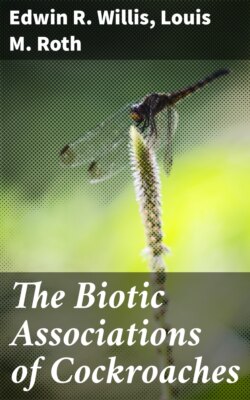Читать книгу The Biotic Associations of Cockroaches - Edwin R. Willis - Страница 299
На сайте Литреса книга снята с продажи.
Parcoblatta uhleriana
ОглавлениеNorth Carolina.—Under pine straw on ground in woods (Brimley, 1908). Under bark of dead trees; 92 males attracted to lights (Rehn and Hebard, 1910).
Virginia.—Resting on woods foliage; at night on road (Rehn and Hebard, 1916).
Eastern and southeastern U.S.—Trapped in molasses-baited jars: in oak and pine woods, in heavy barrier-beach forest, in both scant and typical undergrowth on pine barrens, in heavy grassy undergrowth on pine barrens, on border of pine barrens, on edge of swamp, in heavy deciduous forest, in heavy oak woods, in upland oak and chestnut forest, in chestnut forest, in forested ravine, and on ridge with heavy oak, chestnut, and maple forest. Found under damp leaves on edge of forest, under bark of decayed chestnut log, inside decaying chestnut log with Cryptocercus punctulatus, under palmetto roots, under bark of pine stump, and in dry leaves under live oaks (Hebard, 1917).
Tennessee.—In traps baited with cornmeal or cantaloupe in maple-gum-oak forest in a mesic valley, and in a stand of oak on a dry ridge (Walker, 1957).
Indiana.—Beneath cover on slopes of high wooded hills. "This is essentially a forest-loving species; usually occurring beneath leaves and other debris on or along the borders of heavy hardwood timber." (Blatchley, 1920.)
Illinois.—In oak-hickory forest on clay and in climax forest (Strohecker, 1937).
Michigan.—In oak-dune woods (Hubbell, 1922). Restricted to woodlands, where it inhabited piles of moist dead leaves and rotten logs in oak-hickory forest (Cantrall, 1943).
U.S.A.—This species, P. uhleriana, and P. virginica were attracted at night to honeydew secreted by aphids on Pyrus sp. (Davis, 1918).
